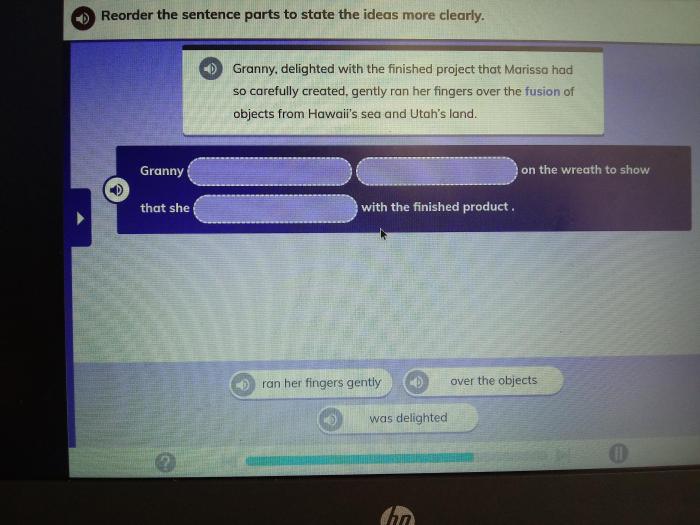Reorder the sentence parts to state the ideas more clearly – Reordering sentence parts is a powerful technique that allows writers to enhance the clarity and impact of their written communication. By strategically rearranging the subject, verb, object, and modifiers of a sentence, writers can emphasize key ideas, improve readability, and create a more coherent and persuasive message.
This comprehensive guide will delve into the principles and practices of sentence reordering, empowering you to effectively convey your ideas and engage your readers with precision and clarity.
Reordering Sentence Parts for Clarity

The structure of a sentence plays a crucial role in conveying ideas effectively. A well-structured sentence ensures clarity and precision, enabling readers to comprehend the intended message effortlessly. However, sentences with unclear or disorganized structure can lead to confusion and ambiguity.
Identifying Sentence Parts
Understanding the different parts of a sentence is essential for effective reordering. A sentence typically consists of the subject, verb, object, and modifiers. The subject is the noun or pronoun performing the action, the verb is the action being performed, the object is the recipient of the action, and modifiers provide additional information about the subject, verb, or object.
Reordering Methods
Reordering sentence parts can enhance clarity by emphasizing specific elements or creating a logical flow of information. Common reordering methods include:
- Passive vs. Active Voice: Changing the voice of a sentence can shift the emphasis from the subject to the object.
- Fronting: Placing a sentence element at the beginning for emphasis or contrast.
- Inversion: Reversing the order of subject and verb for emphasis or formality.
Creating Coherent Sentences
Coherence is essential in sentence structure. Using transitions, avoiding ambiguity, and maintaining a consistent tense and point of view contributes to a coherent sentence. Transitions connect ideas, ambiguity confuses readers, and inconsistent tense or point of view disrupts the flow of information.
Example Analysis, Reorder the sentence parts to state the ideas more clearly
Consider the following sentence with unclear structure:
The students who are enrolled in the class will receive a syllabus.
By reordering the sentence parts, we can improve clarity:
Students enrolled in the class will receive a syllabus.
The revised sentence places the subject (students) at the beginning, followed by the verb (will receive), and the object (syllabus) at the end. This reordering provides a clear and logical flow of information.
FAQ Corner: Reorder The Sentence Parts To State The Ideas More Clearly
What is the primary benefit of reordering sentence parts?
Reordering sentence parts primarily enhances clarity by emphasizing key ideas, improving readability, and creating a more coherent and persuasive message.
How can I identify the different parts of a sentence?
To identify the different parts of a sentence, look for the subject (who or what the sentence is about), the verb (the action or state of being), the object (the receiver of the action), and any modifiers (words that describe or provide additional information about the subject, verb, or object).
What are some common methods for reordering sentence parts?
Common methods for reordering sentence parts include passive vs. active voice, fronting (placing an element at the beginning of the sentence for emphasis), and inversion (reversing the typical word order).

